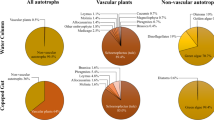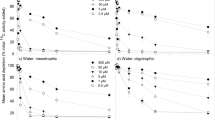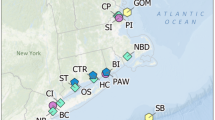Abstract
Zebra mussels (Dreissena polymorpha) are widespread and abundant in major freshwater ecosystems in North America, even though the phytoplankton food resources in some of these systems seem to be too low to sustain them1,2. Because phytoplankton biomass is greatly depleted in ecosystems with large D. polymorpha populations3,4 and bacteria do not seem to be an important food source for this species5, exploitation of alternative carbon sources may explain the unexpected success of D. polymorpha in such environments. Here we examine the possibility that absorption of dissolved organic carbon (DOC) from water6,7,8,9 could provide a nutritional supplement to zebra mussels. We find that mussels absorb 14C-labelled DOC produced by cultured diatoms with an efficiency of 0.23%; this indicates that DOC in natural waters could contribute up to 50% of the carbon demand of zebra mussels. We also find that zebra mussels absorb some dissolved metals that have been complexed by the DOM; although absorption of dissolved selenium was unaffected by DOC, absorption of dissolved cadmium, silver and mercury by the mussels increased 32-, 8.7- and 3.6-fold, respectively, in the presence of high-molecular-weight DOC.
This is a preview of subscription content, access via your institution
Access options
Subscribe to this journal
Receive 51 print issues and online access
$199.00 per year
only $3.90 per issue
Buy this article
- Purchase on Springer Link
- Instant access to full article PDF
Prices may be subject to local taxes which are calculated during checkout

Similar content being viewed by others
References
Strayer, D. L. et al. Arrival, spread, and early dynamics of a zebra mussel ( Dreissena polymorpha) population in the Hudson River estuary. Can. J. Fish. Aquat. Sci. 53, 1143– 1149 (1996).
Madon, S. P., Schneider, D. W., Stoeckel, J. A. & Sparks, R. E. Effects of inorganic sediment and food concentrations on energetic processes of the zebra mussel, Dreissena polymorpha: implications for growth in turbid rivers. Can. J. Fish. Aquat. Sci. 55, 401–413 (1998).
Fahnenstiel, G. L., Lang, G. A., Nalepa, T. F. & Johengen, T. H. Effects of zebra mussel (Dreissena polymorpha) colonization on water quality parameters in Saginaw Bay, Lake Huron. J. Great Lakes Res. 21, 435–448 ( 1995).
Caraco, N. F. et al. Zebra mussel invasion in a large, turbid river: phytoplankton response to increased grazing. Ecology 78, 588–602 (1997).
Findlay, S., Pace, M. L. & Fischer, D. T. Response of heterotrophic planktonic bacteria to the zebra mussel invasion of the tidal freshwater Hudson River. Microb. Ecol. 36, 131–140 (1998).
Stephens, G. C. Uptake of organic material by aquatic invertebrates. III. Uptake of glycine by brackish-water annelids. Biol. Bull. 126, 150–162 (1964).
Ferguson, J. C. A comparative study of the net metabolic benefits derived from the uptake and release of free amino acids by marine invertebrates. Biol. Bull. 162, 1–17 ( 1982).
Wright, S. H., Southwell, K. M. & Stephens, G. C. Autoradiographic analysis of amino acid uptake by the gill of Mytilus. J. Comp. Physiol. B 154 , 249–256 (1984).
Wright, S. H. & Manahan, D. T. Integumental nutrient uptake by aquatic organisms. Annu. Rev. Physiol. 51, 585–600 (1989).
Wotton, R. S. Colloids, bubbles, and aggregates—a perspective on their role in suspension feeding. J. N. Am. Benthol. Soc. 15, 127 –135 (1996).
Decho, A. W. Microbial exopolymer secretions in ocean environments: their role(s) in food webs and marine processes. Oceanogr. Mar. Biol. Annu. Rev. 28, 73–153 (1990).
Ciborowski, J. J. H., Craig, D. A. & Fry, K. M. Dissolved organic matter as food for black fly larvae (Diptera: Simuliidae). J. N. Am. Benthol. Soc. 16, 771–780 (1997).
Campbell, P. G. C. in Metal Speciation and Bioavailability in Aquatic Systems (eds Tessier, A. & Turner, D. R.) 45–102 (Wiley, Chichester, 1995).
Kôuch, J. & Pempkowiak, J. Molecular weight of humic acids as a major property of the substances influencing the accumulation rate of cadmium by a blue mussel (Mytilus edulis). Environ. Int. 22, 585–589 ( 1996).
Carvalho, R. A., Benfield, M. C. & Santschi, P. H. Comparative bioaccumulation studies of colloidally complexed and free-ionic heavy metals in juvenile brown shrimp Penaeus aztecus (Crustacea: Decapoda: Penaeidae). Limnol. Oceanogr. 44, 403–414 ( 1999).
Wang, W. -X., Fisher, N. S. & Luoma, S. N. Kinetic determinations of trace element bioaccumulation in the mussel Mytilus edulis. Mar. Ecol. Prog. Ser. 140, 91–113 (1996).
Kryger, J. & Riisgård, H. U. Filtration rate capacities in 6 species of European freshwater bivalves. Oecologia 77, 34–38 (1988).
Roditi, H. A. & Fisher, N. S. Rates and routes of trace element uptake in zebra mussels. Limnol. Oceanogr. 44, 1730–1749 (1999).
Kepkay, P. E. Particle aggregation and the biological reactivity of colloids. Mar. Ecol. Prog. Ser. 109, 293–304 (1994).
Cutter, G. A. Kinetic controls on the speciation of metalloids in seawater. Mar. Chem. 40, 65–80 ( 1992).
Howarth, R. W., Marino, R., Garritt, R. & Sherman, D. Ecosystem respiration and organic carbon processing in a large, tidally influenced river: the Hudson River. Biogeochemistry 16, 83– 102 (1992).
Findlay, S., Pace, M. L. & Fischer, D. T. Spatial and temporal variability in the lower food web of the tidal freshwater Hudson River. Estuaries 19, 866–873 (1996).
Nichols, S. J. in Zebra Mussels: Biology, Impacts, and Control (eds Nalepa, T. F. & Schloesser, D. W.) 733–747 (Lewis, Boca Raton, 1993).
Walz, N. The energy balance of the freshwater mussel Dreissena polymorpha Pallas in laboratory experiments and in Lake Constance. III. Growth under standard conditions. Arch. Hydrobiol. 55 (suppl.), 121–141 (1978).
Fisher, N. S., Teyssié, J.-L., Fowler, S. W. & Wang, W.-X. Accumulation and retention of metals in mussels from food and water: a comparison under field and laboratory conditions. Environ. Sci. Technol. 30, 3232–3242 (1996).
Sañudo-Wilhelmy, S. A. & Gill, G. A. Phase-speciation of toxic metals in the Hudson River estuary. Eos 77, F200 (1996).
Lee, B.-G. & Fisher, N. S. Degradation and elemental release rates from phytoplankton debris and their geochemical implications. Limnol. Oceanogr. 37, 1345–1360 (1992).
Armstrong, F. A., Williams, P. M. & Strickland, J. D. Photooxidation of organic matter in seawater by ultraviolet radiation, analytical and other applications. Nature 211, 481–487 (1966).
Hedges, J. I. et al. Origins and processing of organic matter in the Amazon River as indicated by carbohydrates and amino acids. Limnol. Oceanogr. 39, 743–761 ( 1994).
Santschi, P. H., Guo, L., Means, J. C. & Ravichandran, M. in Biogeochemistry of Gulf of Mexico Estuaries (eds Bianchi, T. S., Pennock, R. & Twilley, R. R.) 347–380 (Wiley, New York, 1999).
Acknowledgements
We thank J. Cole, G. Stephens and D. Strayer for comments on this manuscript. This work was supported by the New York Sea Grant Institute, the National Association of Photographic Manufacturers, the Hudson River Foundation, and the National Science Foundation (N.F.), and a NOAA NERRS graduate fellowship (H.R.).
Author information
Authors and Affiliations
Corresponding author
Rights and permissions
About this article
Cite this article
Roditi, H., Fisher, N. & Sañudo-Wilhelmy, S. Uptake of dissolved organic carbon and trace elements by zebra mussels . Nature 407, 78–80 (2000). https://doi.org/10.1038/35024069
Received:
Accepted:
Issue Date:
DOI: https://doi.org/10.1038/35024069
This article is cited by
-
Effects of Humic Acids on the Toxicity and Accumulation of Zinc and Cadmium to Chironomid Larvae, Rheocricotopus spp.
Water, Air, & Soil Pollution (2023)
-
Pentaradial eukaryote suggests expansion of suspension feeding in White Sea-aged Ediacaran communities
Scientific Reports (2021)
-
Recycling pathways in cold-water coral reefs: Use of dissolved organic matter and bacteria by key suspension feeding taxa
Scientific Reports (2020)
-
Seasonal distribution, sources and sink of dissolved organic carbon in integrated aquaculture system in coastal waters
Aquaculture International (2017)
-
Influence of the natural Rio Negro water on the toxicological effects of a crude oil and its chemical dispersion to the Amazonian fish Colossoma macropomum
Environmental Science and Pollution Research (2016)
Comments
By submitting a comment you agree to abide by our Terms and Community Guidelines. If you find something abusive or that does not comply with our terms or guidelines please flag it as inappropriate.



